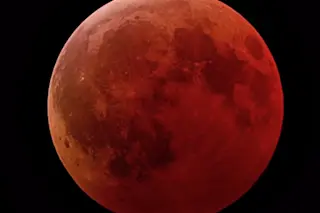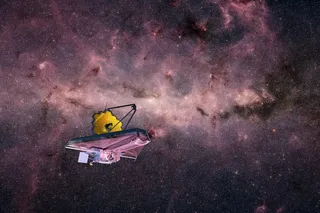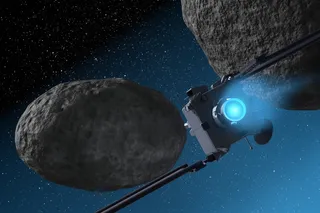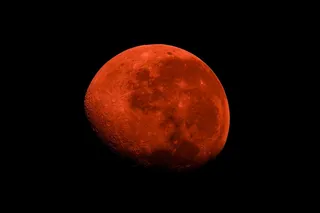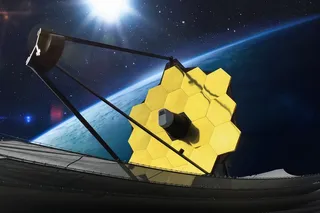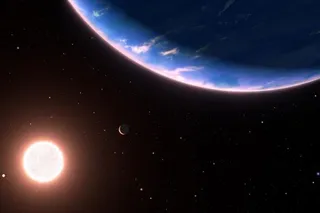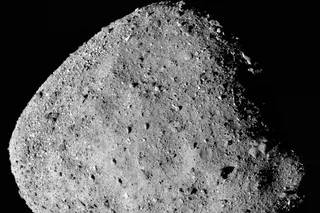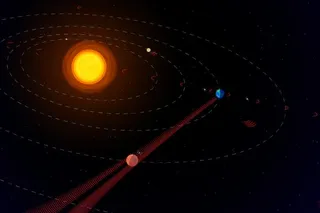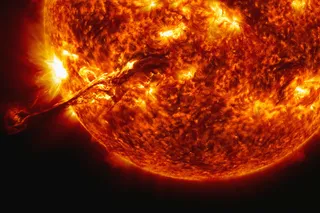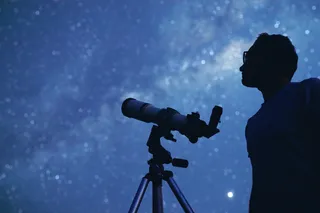A lunar eclipse is one of the universe’s many captivating light shows. During this particular cosmic alignment, the Moon slips into our planet’s shadow, often transforming Luna’s familiar gray face into a stunning red orb.
But what exactly causes a lunar eclipse, and why doesn’t it happen every month? Let's dive into everything you need to know about lunar eclipses, from their causes and frequency, to what makes them so captivating to stargazers worldwide.
What Is a Lunar Eclipse?
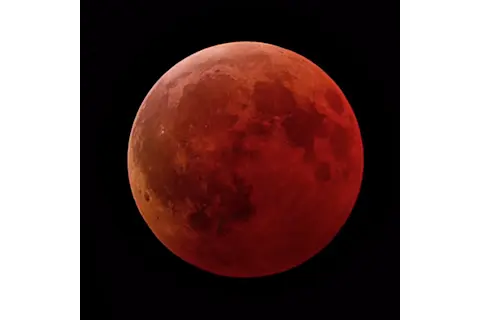
Total lunar eclipse (Credit: NASA)
NASA
A lunar eclipse occurs when Earth is directly between the Sun and the Moon, causing Earth's shadow to fall on the Moon. A lunar eclipse can only occur during a Full Moon, when the Sun, Earth, and Moon are in near-perfect alignment.
There are three types of lunar eclipses: total, partial, and penumbral.
In a total lunar eclipse, the entire Moon passes through Earth's umbra, the darker, inner part of its shadow. During a total lunar eclipse, red wavelengths of sunlight pass through Earth’s atmosphere and reach the Moon, earning it the nickname Blood Moon.
A partial lunar eclipse occurs when only a portion of the Moon enters Earth's umbra, making part of the Moon dark while the rest remains illuminated.
A penumbral lunar eclipse happens when the Moon passes through Earth's penumbra, the lighter, outer part of its shadow. This causes only a subtle dimming, which can be hard to notice without proper attention and equipment.
Read More: Earth's Moon: The Basics of its Origin, Evolution and Exploration
What Causes a Lunar Eclipse?
Lunar eclipses are the result of the intricate yet predictable dance between the Sun, Earth, and Moon. During a lunar eclipse, Earth is positioned between the Sun and the Moon, blocking sunlight that would otherwise illuminate the Moon. Earth's atmosphere also bends and scatters sunlight, filtering out most of the blue light and allowing the red hues to reach the Moon's surface. This is why the Moon often appears noticeably red or orange during a total lunar eclipse.
However, even though the Moon completes a full orbit around Earth approximately every 29.5 days, lunar eclipses don't happen every month. This is because the Moon’s orbit is tilted by about 5 degrees relative to Earth’s orbit around the Sun, so the three celestial bodies do not always perfectly align.
Read More: Totality Touches The Moon During The Lunar Eclipse
How Often Do Lunar Eclipses Occur?
On average, there are about two lunar eclipses each year — though some years can have one, none, or three lunar eclipses. But remember, not all of these are total lunar eclipses. Fortunately, unlike solar eclipses, which are only visible from very specific parts of the world, lunar eclipses can be seen by anyone on the night side of Earth.
The duration of a lunar eclipse can vary, but total lunar eclipses can last for several hours from start to finish. The totality phase, where the Moon is entirely within Earth's umbra, can last up to about 1 hour and 40 minutes. Partial and penumbral eclipses are shorter in duration, as the Moon is not fully passing through Earth’s shadow.
Read More: The Beginning of Ramadan Is Signaled by Observations of the Moon
Here's What a Lunar Eclipse Looks Like
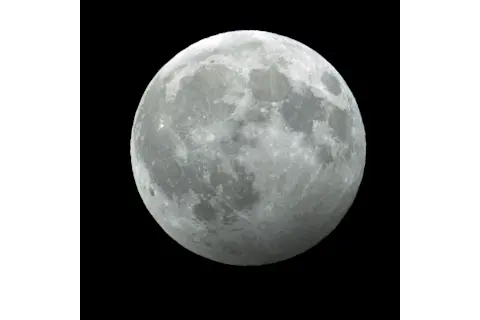
Penumbral lunar eclipse (NASA)
The appearance of a lunar eclipse can vary greatly depending on its type. During a total lunar eclipse, the Moon can turn a deep red, creating a beautiful, somewhat ethereal sight. This red color comes from sunlight passing through Earth’s atmosphere and reaching the Moon. (Blue light scatters more easily in Earth’s atmosphere, while red light largely makes it through.) The exact shade of red can also vary depending on Earth's atmospheric conditions at the time, such as the presence of volcanic dust or wildfire smoke.
In a partial lunar eclipse, the contrast between the shadowed and illuminated parts of the Moon can be striking. You'll see a portion of the Moon in deep shadow, while the rest remains bright, making for a unique and memorable view. A penumbral lunar eclipse is much more subtle, with the Moon appearing only slightly dimmer than usual, which can be challenging to observe without careful attention.
Read More: What Does a Lunar Eclipse Look Like From the Moon?
The Difference Between a Solar and Lunar Eclipse
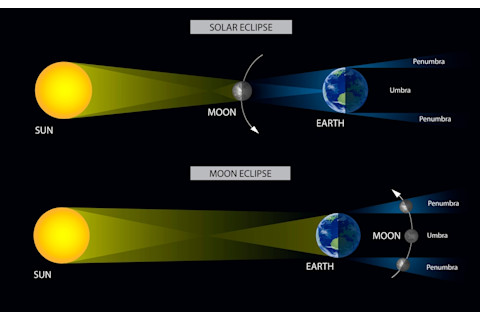
(Credit: Zaporizhzhia vector/Shutterstock)
Zaporizhzhia vector/Shutterstock
While both solar and lunar eclipses involve the alignment of the Sun, Earth, and Moon, they are vastly different sights to see. A solar eclipse occurs when the Moon passes between the Sun and Earth, casting the Moon’s shadow on Earth and blotting out the Sun. This can only happen during a New Moon. A lunar eclipse, on the other hand, happens during a Full Moon, when Earth is between the Sun and the Moon.
Another key difference is visibility. Solar eclipses are only visible from specific areas on Earth and require special eyewear to safely observe. Lunar eclipses, however, can be seen from anywhere on Earth's night side and can be viewed without any protective equipment.
Read More: Your Ultimate Guide to Solar Eclipses
Go See for Yourself!
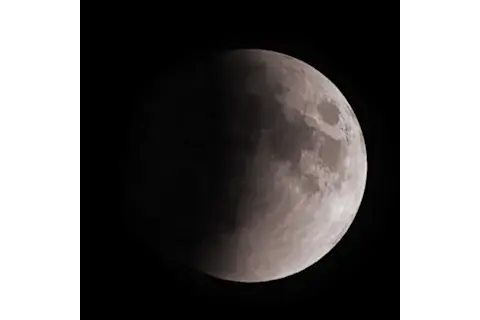
Partial lunar eclipse (Credit: NASA)
NASA
Lunar eclipses are not just a fascinating natural phenomenon, but also an opportunity to connect our solar system. Whether you're casually watching the Moon turn red during a total lunar eclipse or scrutinizing the subtle brightness changes during a penumbral eclipse, these events are great opportunities to connect — or reconnect — with the night sky.
And by the way, the next lunar eclipse is just days away. On the night of September 17/18, the Moon will undergo a partial lunar eclipse, with just the slightest bit of its disk passing into Earth’s dark umbral shadow. Can you spot the small bite in the Moon’s disk?
Read More: From a Pink Moon to Blue, the Moon's Colors Aren't Always Colorful
Article Sources
Our writers at Discovermagazine.com use peer-reviewed studies and high-quality sources for our articles, and our editors review for scientific accuracy and editorial standards. Review the sources used below for this article:
NASA. Eclipses
National Air and Space Museum. Lunar Eclipse Diagram
NASA. Red Moon Rising
Time and Date. What Is a Penumbral Lunar Eclipse?
National Weather Service. Solar and Lunar Eclipses
NASA. Moon in Motion
Britannica. The frequency of solar and lunar eclipses
National Air and Space Museum. Total Lunar Eclipse
Encyclopedia of Physical Science and Technology. Lunar Eclipse
Astronomy. A penumbral challenge
Time and Date. What Is a Partial Lunar Eclipse?


